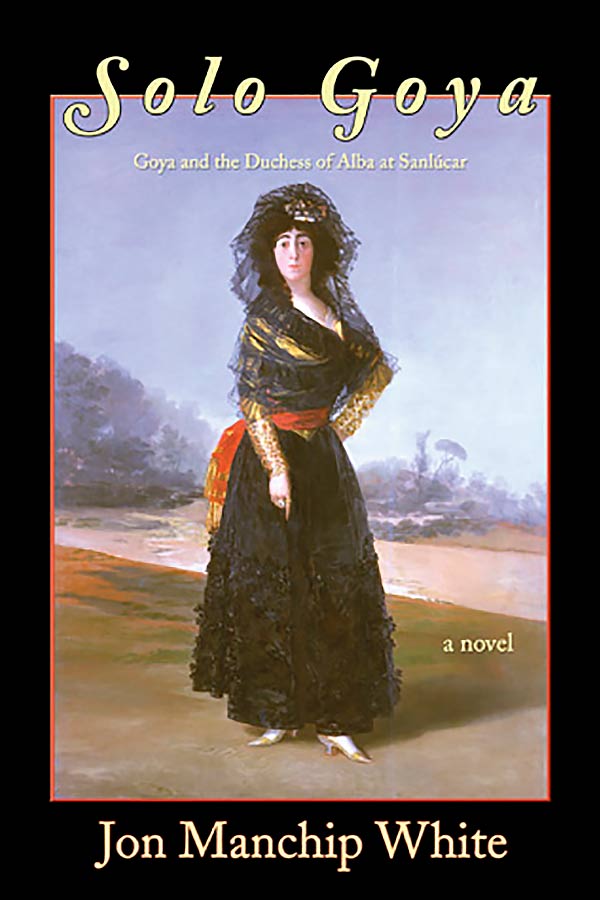Description
Solo Goya: Goya and the Duchess of Alba at Sanlúcar is a meticulously researched historical novel about the great Spanish painter Francisco Goya and his most famous patron, the 13th Duchess of Alba. The encounter between Goya and the Duchess of Alba which figures in this novel took place at Sanlúcar de Barrameda in the late summer of 1796, when Goya was aged 50 and the Duchess was a widow of 34. These facts and many others in this story are historically accurate, and most of the characters you will meet in this book actually lived at that time and place. But this is a novel, a work of fiction, and not a book of history. Since many of the details of Goya’s life are obscure or in dispute, the goal of this book is not to prove that this detail or that actually took place, but to create a plausible and engaging narrative that brings to life the major issues and ambiance of life in late 18th century Bourbon Spain. Author Jon Manchip White is uniquely equipped to recreate the world in which Goya lived – the artist’s easy access to extremes of social class, the dominance of the Catholic Church, and his cultural preoccupations with war, violence, religion, art and politics.
The most important source of information about the details of Goya’s life comes from his paintings and prints, and Manchip White makes heavy use to this source in developing his story. Most of the events in this novel are informed by specific works of art. Goya painted two full length portraits of the Duchess of Alba: “The White Duchess” a semipublic painting made in 1795 in Madrid before the death of the Duchess’ husband, Don José Álvarez de Toledo y Gonzaga, in 1796, and “The Black Duchess” a private painting made in 1797 in Sanlúcar after the death of the duke. In this later work the index finger, bearing a ring inscribed “Goya,” points to the ground where, scratched in the dirt are the words, “Solo Goya” (Goya alone.) These words were painted over and were only discovered in the 20th century when the painting was being cleaned. The painting stayed in Goya’s possession until his death at the age of 82 – 26 years after the death of the Duchess. Many of Goya’s other works feature the Duchess. He made several drawings of scenes in the domestic life of the Duchess and her household at Sanlúcar. She is also recognizable in several plates of Los Caprichos and in one unpublished etching, which seems to record an estrangement from the artist. Goya’s paintings, sketches and prints also portray other characters in this novel in various situations, so the art becomes a window on the artist’s world and his feelings.
Jon Manchip White captures this world, its complexity, color and intense emotion with vivid clarity. At this time in Goya’s life Spain was a major player in a period of great historic importance. The newly established United States was struggling to become a major power and the French Revolution was well under way. Goya was an artistic genius living in a crucial, complex and interesting time. In Solo Goya you are there.
Praise for Solo Goya
The anguish and joy of making art, the anguish and joy of living life—Jon Manchip White knows a great deal about these matters and better than that has the gift for making intelligent and entertaining prose fiction about them. Any one of his many books is a gift to serious readers and, lucky for all of us, here is another.
—Alan Cheuse
Listening to the Page and The Light Possessed
From the biographer of Velázquez and Cortés comes another deeply imagined and history-steeped portrait of a Spanish genius—Francisco Goya in his increasing age. Perhaps no painter more entirely speaks to and predicts the modern sensibility, and Jon Manchip White brings him—compellingly, vividly, passionately—back to fictive life. Here’s a book both accurate and fanciful, a tale that I admired from first to final page.
—Nicholas Delbanco
What Remains and Spring and Fall
Solo Goya is the brilliant story, passionately rendered, of a great artist and of his tragic muse. Jon Manchip White deftly summons up credible and fully dimensional characters, and brings the past to renewed and sensuous life. This is historical fiction at its finest.
—George Garrett
Death of the Fox
Jon Manchip White’s Solo Goya immerses the reader in eighteenth-century Spain and, more particularly, in the intense and unlikely love affair the painter Francisco Goya had with one of his patrons, the Duchess of Alba. This tale of passions and politics is full of drama and comic irony. Jon Manchip White is a master of language who uses color, texture, and nuance to vividly render emotion. Solo Goya has the haunting power of a Goya painting.
—Allen Wier
Blanco and Tehano




